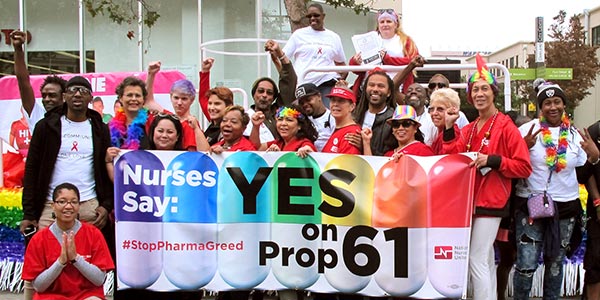Press Release
Nurses: Drug Costs, Up 761% in Past Decades Will Continue to Skyrocket Without Actions Like Prop. 61

In new research data released today, the California Nurses Association/National Nurses United reports that spending on drugs will likely grow 80 percent over the next decade, after having skyrocketed by 761 percent since 1984, unless direct action, such as is proposed in California by Proposition 61 on the state’s November ballot.
Under Prop. 61, the state would be required to pay no more for prescription drugs for patients it covers than the discount prices, which can be up to 40 percent less, paid by the Department of Veterans Affairs. CNA, the largest nurses organization in California, has been campaigning for Prop. 61, citing the calamitous effects on patients harmed by high drug prices.
In advance of Californians casting ballots, CNA will be releasing a series of research policy statements through its research arm, the Institute for Health and Socio-Economic Policy.
The first 9-page report, titled "Tough Pill to Swallow – The High price of Prescription Drugs in the U.S.", may be read on-line.
It includes some eye-popping data:
- Brand name drugs’ prices increased by 164 percent from 2008 to 2015.
- Price gouging even affected generic drug prices; nearly 400 generics showed price hikes of more than 1,000 percent between 2008 and 2015.
- The average price of cancer drugs increased by more than ten fold in the decade after 2000.
Specialty medications spurred much of the astronomical price hikes:
- Biogen Idec’s multiple sclerosis drug Tecfidera costs $54,900 for a year of treatment.
- Vertex Pharmaceutical’s cystic fibrosis drug costs $259,000 annually.
- Gildead’s Sovaldi, the well known drug viewed as a game changer for patients with hepatitis C, is set at $1,000 a pill, or $84,000 for a 12-week course of treatment, prices so high that they have been rationed for thousands of patients on Medicaid and forced long delays in access to care.
IHSP’s initial report finds a stark contrast with prices for drugs in the U.S. compared to other countries.
- U.S. prices for the world’s top 20 selling drugs were three times higher than in Britain, six times higher than in Brazil, and 16 times higher than the lowest priced country, usually India.
- Medicare, which accounts for 28 percent of all drug purchases in the U.S. paid more than similar programs in Great Britain for 39 of the top 40 branded drugs, 37 of the top 40 in Norway, and 28 out of 30 in Ontario, Canada.
Due to pharmaceutical industry lobbying, Congress has repeatedly defeated proposals to allow Medicare to negotiate bulk purchasing discounts as most other industrial countries utilize to curb inflated drug prices.
One U.S. agency that is permitted to bargain discount prices is the Department of Veterans Affairs, the reason Prop. 61 uses that standard in its approach. “Researchers have concluded that the federal government could save (up to) $22.8 billion annually if Medicare negotiated with drug manufacturers and achieve the same prices as those paid” by the DVA, the IHSP notes.
The impact on patients is often devastating.
- Because of the high cost, nearly one in 10 Americans do not take their medications according to the Centers for Disease Control and, according to the Commonwealth Fund, 35 million Americans skipped prescriptions.
In a recent commentary in the San Diego Union Tribune, Markowitz and San Diego RN Dahlia Tayag wrote, "As nurses, we see families who can’t afford the medications they or their children need, or they have to give up other basic necessities. It’s heartbreaking and it’s unconscionable. Californians can take some control back by voting yes on Proposition 61."